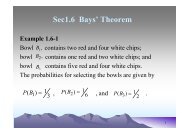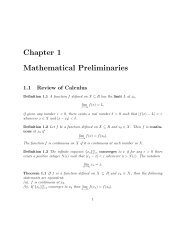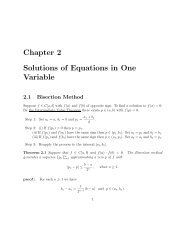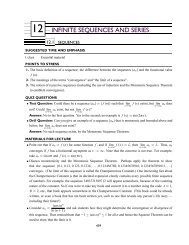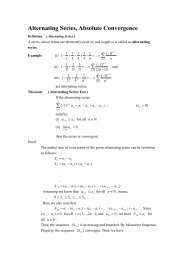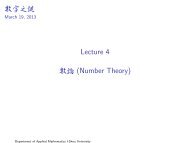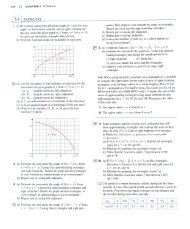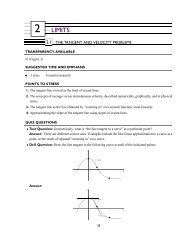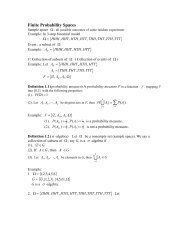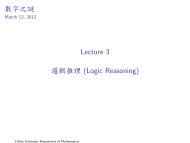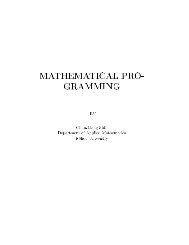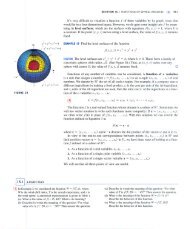[ill x = j .JY (y - 3),
[ill x = j .JY (y - 3),
[ill x = j .JY (y - 3),
Create successful ePaper yourself
Turn your PDF publications into a flip-book with our unique Google optimized e-Paper software.
argument similar to that for consumer surplus shows that the<br />
surplus is given by the integral<br />
r [P - Ps(x)] dx<br />
Calculate the producer surplus for the supply function<br />
Ps(x) = 3 + 0.01x 2 at the sales level X = 10. Illustrate by<br />
drawing the supply curve and identifying the producer surplus<br />
as an area.<br />
7. If a supply curve is modeled by the equation<br />
p = 200 + 0.2x Jl2 , find the producer surplus when the<br />
selling price is $400.<br />
8. For a given commodity and pure competition, the number of<br />
units produced and the price per unit are determined as the<br />
coordinates of the point of intersection of the supply and<br />
demand curves. Given the demand curve p = 50 - dox and<br />
the supply curve p = 20 + lox, find the consumer surplus<br />
and the producer surplus. Illustrate by sketching the supply<br />
and demand curves and identifying the surpluses as areas.<br />
ffi 9. A company modeled the demand curve for its product<br />
(in dollars) by the equation<br />
800,000e- x / 5OOO<br />
x + 20,000<br />
Use a graph to estimate the sales level when the selling price<br />
is $16. Then find (approximately) the consumer surplus for<br />
this sales level.<br />
~ A movie theater has been charging $7.50 per person and selling<br />
about 400 tickets on a typical weeknight. After surveying<br />
their customers, the theater estimates that for every 50 cents<br />
that they lower the price, the number of moviegoers w<strong>ill</strong><br />
increase by 35 per night. Find the demand function and calculate<br />
the consumer surplus when the tickets are priced at $6.00.<br />
II. If the amount of capital that a company has at time t is f(t),<br />
then the derivative, .f'(t), is called the net investment flow.<br />
Suppose that the net investment flow is jt m<strong>ill</strong>ion dollars per<br />
year (where t is measured in years). Find the increase in capital<br />
(the capital formation) from the fourth year to the eighth<br />
year.<br />
12. If revenue flows into a company at a rate of<br />
f(t) = 9000J1+2[, where t is measured in years andf(t) is<br />
measured in dollars per year, find the total revenue obtained<br />
in the first four years.<br />
13. Pareto's Law of Income states that the number of people with<br />
incomes between x = a and x = b is N = f: Ax- k dx, where<br />
A and k are constants with A > 0 and k > 1. The average<br />
income of these people is<br />
1 fh<br />
:x = - Ax 1 -k dx<br />
N a<br />
14. A hot, wet summer is causing a mosquito population explosion<br />
in a lake resort area. The number of mosquitos is<br />
increasing at an estimated rate of 2200 + lOeO St per week<br />
(where t is measured in weeks). By how much does the mosquito<br />
population increase between the fifth and ninth weeks<br />
of summer?<br />
15. Use Poiseu<strong>ill</strong>e's Law to calculate the rate of flow in a small<br />
human artery where we can take TJ = 0.027, R = 0.008 em,<br />
1 = 2 em, and P = 4000 dynes/cm 2 •<br />
16. High blood pressure results from constriction of the arteries.<br />
To maintain a normal flow rate (flux), the heart has to pump<br />
harder, thus increasing the blood pressure. Use Poiseu<strong>ill</strong>e's<br />
Law to show that if Ro and Po are normal values of the radius<br />
and pressure in an artery and the constricted values are Rand<br />
P, then for the flux to remain constant, P and R are related by<br />
the equation<br />
Deduce that if the radius of an artery is reduced to threefourths<br />
of its former value, then the pressure is more than<br />
tripled.<br />
ULJ The dye dilution method is used to measure cardiac output<br />
with 6 mg of dye. The dye concentrations, in mg/L, are modeled<br />
by c(t) = 20te- 06t , 0 ~ t ~ 10, where t is measured in<br />
seconds. Find the cardiac output.<br />
18. After an 8-mg injection of dye, the readings of dye concentration,<br />
in mg/L, at two-second intervals are as shown in the<br />
table. Use Simpson's Rule to estimate the cardiac output.<br />
t c(t) t c(t)<br />
0 0 12 3.9<br />
2 2.4 14 2.3<br />
4 5.1 16 1.6<br />
6 7.8 18 0.7<br />
8 7.6 20 0<br />
10<br />
5.4<br />
19. The graph of the concentration function c(t) is shown after a<br />
7-mg injection of dye into a heart. Use Simpson's Rule to<br />
estimate the cardiac output.<br />
y<br />
L)<br />
6<br />
4<br />
2 I<br />
--- I--<br />
/<br />
/ "'- "-<br />
"'- "'-<br />
........•....<br />
0 2 4 6 8 10 12 14 I(<br />
r--



